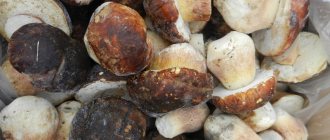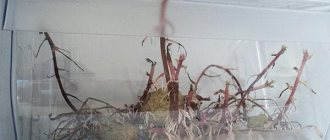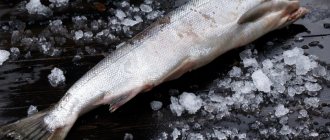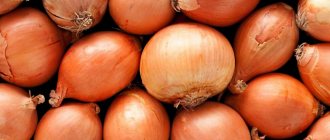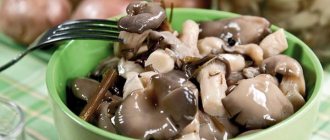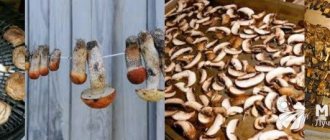What mushrooms can be stored in the freezer?
Forest mushrooms grown independently on the site and purchased are suitable for freezing.
According to their structure they are divided into:
- tubular (boletus, boletus, porcini mushroom, etc.);
- lamellar (milk milk, russula, volushka, honey mushrooms, etc.);
- marsupials (morel, truffle, stitch).
Marsupials must be boiled before freezing. It is advisable to boil lamellar ones too. Tubular ones are frozen raw. They have a porous cap that absorbs a lot of moisture when boiled, so after defrosting they become watery.
After defrosting, champignons, honey mushrooms, boletus, aspen, moss mushrooms and porcini mushrooms retain their shape and structure. Butter butter, after being frozen raw and defrosted, loses its structure, becomes soft or crumbles into porridge.
Reference. For long-term storage, it is better to dry the porcini mushroom - this way it will retain its full aroma.
Mushrooms with a bitter taste (conditionally edible) - saffron milk caps, milk mushrooms, chanterelles, russula, strings, volnushki and morels - are boiled before freezing. After heat treatment in salt water, the bitterness and toxic substances leave them.
Fresh mushrooms are frozen. Overgrown, large and damaged by insects cannot be frozen. They may accumulate toxic substances that are harmful to health.
Signs of a stale product:
- no fresh mushroom smell;
- slime;
- dark spots on the cap;
- the cap is dry, cracked;
- the lower part of the cap of lamellar mushrooms has darkened;
- there is no elasticity; when pressed, voids are felt.
Such mushrooms cannot be eaten or frozen.
How to prepare mushrooms for freezing
Mushrooms are perishable foods. After collection or purchase, they are immediately processed and sorted by type. Each is frozen separately and in different ways: tubular - in raw form, marsupial and lamellar - in boiled form. Whole, elastic, young specimens are selected. After sorting, they are cleared of debris, and the lower part of the stem is cut off if it is in the ground. Contaminated caps are cleaned with a knife or sponge. Cut off all insect-damaged areas and dark spots.
Before freezing raw mushrooms, wipe or wash with water, do not soak. Then lay them out on a paper towel to dry. If you plan to boil or fry them before freezing, pre-soak them in salt water so that all the dirt is soaked off and hidden worms come to the surface. Then they are washed in cold water and placed in a colander to drain excess moisture.
To get a quality product, adhere to the following rules:
- Only whole, undamaged specimens are used for freezing.
- Do not soak raw before freezing. When frozen, excess moisture crystallizes and destroys the structure of the mushroom.
- To maintain the shape of whole mushrooms, they are frozen on a tray and then placed into storage containers.
- To preserve color, blanching is used before freezing.
- The storage container is filled completely, leaving a minimum amount of air. This preserves the natural mushroom flavor.
- To protect the product from foreign odors, use airtight storage containers.
- Instant freezing allows you to preserve vitamins and nutrients to the maximum.
- Thawed product cannot be re-frozen. Therefore, mushrooms are frozen in small single portions.
- When freezing a cooked product with broth, the taste and aroma are preserved.
- Defrost mushrooms on the bottom shelf of the refrigerator - this way they retain their taste and smell.
How to process milk mushrooms after harvesting
When the harvest is delivered home, you can’t wait too long. You need to immediately start preparing everything you need to help you clean the fruiting bodies efficiently. To complete the procedure you need:
- The round container is larger in volume than mushrooms. A saucepan, basin, bucket or plastic barrel will do. If there is too much harvest, several containers will be needed.
- Cold water is needed, preferably running water. If there is no running water, you can use a well. In the second option, you will often have to change the water manually using buckets.
- A knife with a sharp blade is necessary for trimming the lower part of the stem, damaged areas, and will help better clean dirt from the cap.
- A brush with soft bristles or a regular sponge is used when washing mushrooms. Cleaning with a device with rough bristles is unacceptable. It will damage the fruiting body.
When everything is prepared, an important moment begins - processing the milk mushrooms before cooking or salting.
How to quickly clean milk mushrooms from dirt
The harvest delivered from the forest must be cleaned, but first it is subjected to pre-treatment. First of all, sort out all the mushrooms. Old milk mushrooms, damaged by slugs or worms, and questionable fruiting bodies are thrown away. If the damage is minor, you can cut it with a knife. The sorted mushrooms are cleaned by hand from large debris. If necessary, clean the surface of the cap with a knife, scraping off adhering leaves and grass.
It is convenient to clean dirt from the surface of the cap with a knife.
After completing the “rough” cleaning, the milk mushrooms are washed with running water. It is optimal to load them in portions into a colander and place them under the water tap. The washed fruiting bodies are placed in a container and filled with cold water for 3 hours. During this time, the adhered dirt will fall off. Heavily soiled caps are cleaned with a brush.
Dirty water is drained, after which a new portion is immediately poured. To prevent milk mushrooms from floating, cover them with a large dish or lid and place a load on top, for example, a jar of water. Soaked mushrooms last for a day. During this time, the fine dirt that has eaten into the body of the milk mushrooms will fall away, and the insects will die. During the day, the water will have to be changed every 4-5 hours. If this is not done, the fruiting bodies will turn sour.
Advice! So that during soaking the milk mushrooms do not lose their taste, add 1 tbsp to 6 liters of water. l. salt or citric acid.
How to quickly wash milk mushrooms
After a day of soaking, the main dirt will fall off. The water is drained from the container. To further properly clean milk mushrooms after soaking, arm yourself with a brush or sponge. The washing process begins. Mushrooms are filled with clean cold water. Each cap is cleaned by rubbing in a circular motion with a brush or sponge. Cleaning the cap from the spore-bearing layer is a controversial matter. Usually sand accumulates between the plates, which is difficult to remove even by soaking. If the harvest was carried out in the forest on sandy soil, then it is better to cut out the spore-bearing layer with a knife. Rural residents who collect milk mushrooms in ecologically clean, non-sandy areas do not do this.
Popular articles Do-it-yourself topiary haircut of thuja
To wash mushrooms you will need a large container, such as a bucket.
Advice! To easily clean large milk mushrooms, cut them into 2-3 parts.
The processed mushrooms are washed again and placed in another container with clean salted water. Here they have to get wet for another day. The next day they are simply washed under running water, no longer cleaned, and used for cooking.
In what mode and for how long can frozen mushrooms be stored in the freezer?
Mushrooms are frozen whole at a temperature of -28°C, sliced or caps at a temperature from -18 to -20°C. The shelf life of frozen mushrooms is up to 1 year.
It depends on the temperature maintained in the freezer:
- up to 4 months at temperatures from -12 to -14°C;
- up to 6 months at temperatures from -14 to -18°C;
- up to 1 year at temperatures from -18 to -24°C.
How long can boiled frozen mushrooms be stored in the freezer? The shelf life of boiled and blanched is 5 months, fried is 3 months.
For storage use plastic containers or plastic bags.
How to freeze for the winter: all methods
For the winter, mushrooms are frozen fresh, boiled or fried. Before freezing, they are sorted, cleaned of debris and dirt, and damaged parts are removed.
If frozen fresh, rinse before storing and then dry on a paper towel. Mushrooms that will be boiled or fried are pre-soaked in salted water (200 g of salt per 5 liters of water). Then rinse and drain in a colander to drain excess liquid.
Fresh
Tubular ones are frozen fresh. Small specimens are frozen whole, large ones are cut into slices 1-2 cm thick. Place on a tray and place in the freezer for 12 hours. Then they are taken out, packaged in plastic containers or plastic bags in small portions and stored in the freezer.
Advice. To make it easier to keep track of the expiration date, label the storage container indicating the freezing date.
Boiled
Before freezing, lamellar and marsupials are boiled. They are cleaned, cut, dipped in boiling water and boiled for 5-10 minutes.
Then place in a colander to drain excess water. After cooling, place into plastic containers or plastic bags in portions. Enter the freezing date and put it in the freezer.
Fried
All types of mushrooms are suitable for this freezing method. They are cut into slices and fried in a small amount of vegetable oil until golden brown for 20-30 minutes. Spices and salt are not added.
Then place on paper towels to absorb excess fat. The finished product is packaged in plastic bags or plastic containers. The container is signed and placed in the freezer for storage. The resulting product is completely ready for use after defrosting.
Instead of frying the mushrooms, you can bake them in the oven. They are cut and placed on a baking sheet covered with parchment paper. No oil is added. Bake until done, cool. Place in small single portions into airtight containers and freeze. Store in the freezer. With this method, the taste and aroma are preserved as much as possible.
What to do with mushrooms after picking them?
Having brought home the mushrooms collected in the forest, you need to carry out the following manipulations without delay:
- Go through them, removing dirt, stuck leaves, twigs, needles, and get rid of damaged specimens.
- Sort and lay out on the table to dry.
- The latter is important because wet mushrooms will not last long.
- It is best to pick mushrooms in dry, sunny weather, since mushrooms collected in the rain will take longer to dry.
- Dried mushrooms should be placed in containers for refrigeration.
Often, after picking mushrooms, the owners are so tired that they do not have the strength to immediately process them; in this case, as well as in the case of too many collected mushrooms, they can be stored in the refrigerator for up to a day.
But there is not much time to store mushrooms in the refrigerator, so it is advisable to immediately process and store them. The easiest way is to preserve it in jars or at least boil it.
Defrosting rules
Mushrooms frozen raw are thawed on the bottom shelf of the refrigerator, and then kept at room temperature, but no more than 1 hour. Boiled and fried products are not previously defrosted. It is immediately added to the dish during the cooking process.
This is interesting:
Storing sushi and rolls at home in the refrigerator.
How long can shrimp be stored, boiled and frozen?
In what container can boiled mushrooms be stored?
Experienced mushroom pickers and housewives advise storing boiled forest harvests in metal containers with an enameled inner coating or containers made of ceramics, plastic, nylon and glass.
Containers made of iron and aluminum are not suitable for storing boiled crops.
Polyethylene bags are allowed, but not recommended for storage. In them, it is more difficult for the product to breathe, which makes its storage time minimal. Another great option for storing boiled mushrooms is glass jars. Boiled forest harvest feels great in them.

